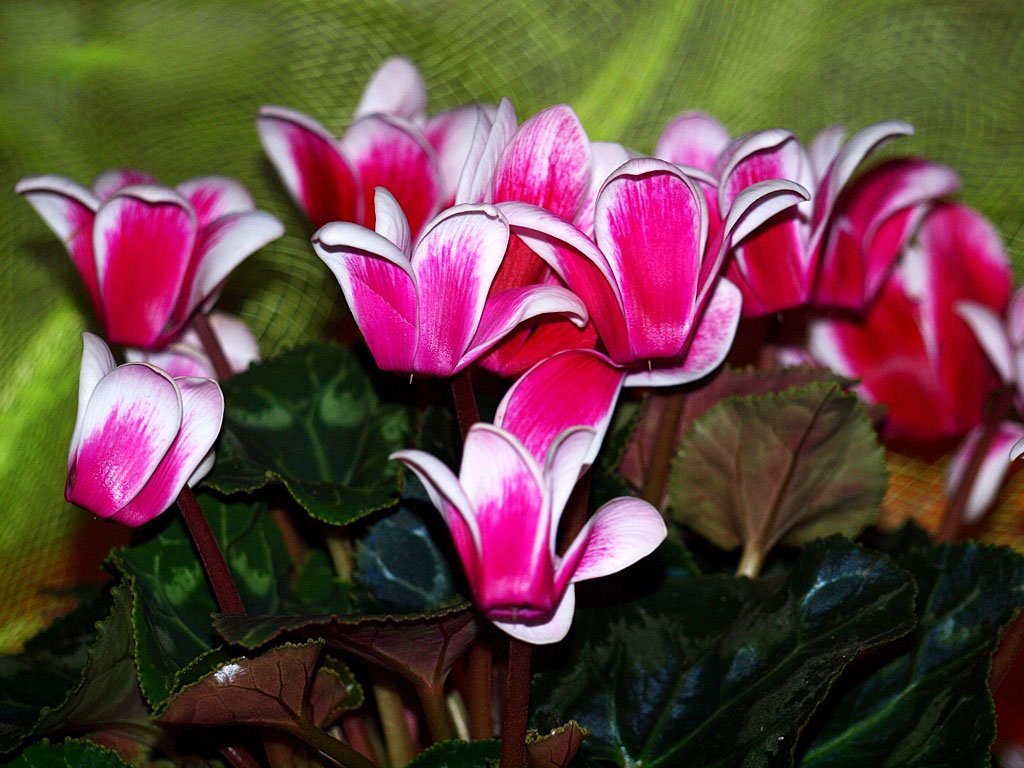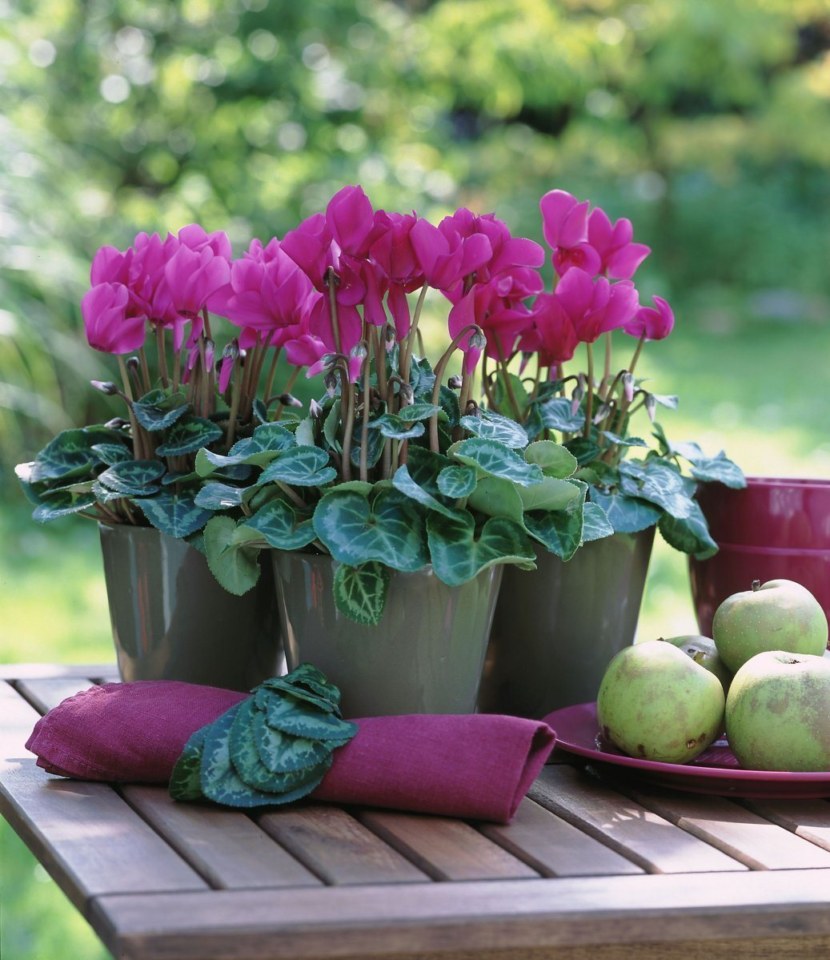In autumn and winter, when many indoor plants have already faded and are dormant, cyclamen begins to bloom. With proper and careful home care, this perennial plant will delight you with its luxurious flowering from September to March. Both beginners and experienced gardeners appreciate the hero of the article for its bright various colors, pleasant aroma and various methods of propagation. The diverse hybrid forms of this flower, bred by breeders, will allow you to choose the color scheme of an indoor plant for any interior.
General description and types of cyclamens
Cyclamen or alpine violet Is a small tuberous perennial with wide leaves and unusual bright flowers. The flower leaves are distinguished by ideal proportions and various patterns. The flowers of the plant rise above the foliage and can be small or large, with a wide variety of colors.
Natural flowers are ephemeroids. This means that the leaves and flowers grow only a few months of the year, and the rest of the time the tuber of the plant sleeps underground. Nowadays, there are many hybrid varieties of alpine violets that can grow and bloom almost throughout the year.
All cyclamen are divided into two types and many varieties, which differ in color, doubleness and size of flowers and the height of the plant itself.
Heightare divided into three groups:
- undersized grow up to 15 cm;
- medium-high - up to 20 cm;
- standard - up to 30 cm.
Types of cyclamen
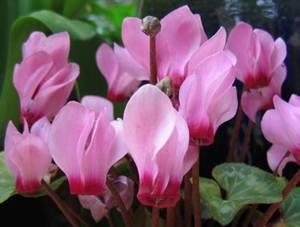 Persian is distinguished by a thickened spherical tuber, from the lower surface of which roots extend. The leaves of the plant are rounded and green with a silvery or gray pattern. On long juicy peduncles, graceful large flowers are singly located, which are very look like butterfly wings... The life span of one flower is about ten days. However, during flowering, about 100 flowers can bloom on the plant, so the Persian cyclamen blooms for a long time from October to March.
Persian is distinguished by a thickened spherical tuber, from the lower surface of which roots extend. The leaves of the plant are rounded and green with a silvery or gray pattern. On long juicy peduncles, graceful large flowers are singly located, which are very look like butterfly wings... The life span of one flower is about ten days. However, during flowering, about 100 flowers can bloom on the plant, so the Persian cyclamen blooms for a long time from October to March.
The European cyclamen is native to southern and central Europe and is rare in indoor collections. The tubers of the plant are most often of irregular shape. Small flowers up to 2 centimeters long have a pink color and a pleasant smell. The plant blooms from May to September.
How to care?
At home, caring for a flower is not very difficult, but requires compliance with some rules.
- First of all, you need to find a suitable place for the alpine violet. The plant, although unpretentious, loves diffused light and well-ventilated rooms. Drafts are contraindicated in the flower.
- Temperature conditions are very important. It belongs to cold-loving plants, therefore it does not tolerate high temperatures. An alpine violet feels comfortable at temperatures ranging from + 14C to + 16C.
- If in the summer it is not possible to maintain the temperature optimal for growth, then the plant can be transferred to the basement. However, there should be sufficient lighting in the room. If this is not possible, then the flower can be left in a room where the air temperature should not exceed + 25C.
- In winter, when heaters and central heating radiators are switched on in the room, it is recommended to place the cyclamens away from heat sources. In this case, you need to monitor the level of humidity in the room, and water the plant in a timely manner.
- Too low room temperatures and excessive watering can lead to rotting, and then to the death of the flower.
How to water properly?
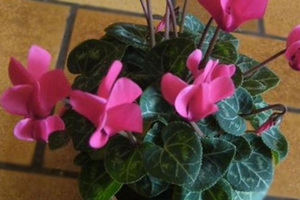 Alpine violet is moisture-loving plant, which at home must be watered in a timely manner, abundantly and regularly.
Alpine violet is moisture-loving plant, which at home must be watered in a timely manner, abundantly and regularly.
At any time of the life of a flower, watering requires accuracy. Cyclamen is recommended to be watered through a tray, since water ingress on the stems, peduncles or tuber provokes rotting. Cuttings or flowers first begin to become covered with brown spots, and then the plant dies.
Water for watering the plant should be at room temperature and be separated. Watering plants with tap water is not recommended. If the flower requires watering, and there was no settled water in the house, then you can pour it with boiled water, previously cooled to room temperature.
When caring for an alpine violet, it is necessary to ensure that the water in the pan and pot does not stagnate for a long time. After the flower is watered, and all layers of soil are saturated with moisture, from the pallet need to pour out excess water.
The Persian tuber rises above the soil, so the plant can be watered in the usual way.
Top dressing
Twice a month, during the period of active growth of leaves and during flowering, the alpine violet should be fed.
It is recommended to feed at home during watering with special fertilizers for flowering plants. At the same time, one should not abuse nitrogen fertilizers, an excess of which will negatively affect the quantity and quality of flowers, and lead to a strong foliage build-up.
Resting care
After the plant has faded, its leaves start to turn yellow and fall off... This is the first sign that the flower is entering a dormant period. At this time, at home, the alpine violet requires special care.
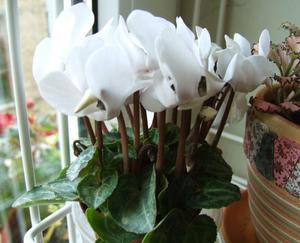 All dry leaves and flowers must be cut off.
All dry leaves and flowers must be cut off.- Strong leaves need to be cut closer to the root. It is not recommended to cut them off.
- It is necessary to water the plant rarely and in small doses. The soil should be slightly damp all the time.
- It is recommended to rearrange the pot in a cool shady place.
After flowering, the life of the alpine violet is supported by its tuber.
Transfer
Caring for a plant at home includes a flower transplant, which is usually done during the summer. Moreover, it is necessary follow some rules:
- after transplanting, the upper third of the plant's tuber should remain above the ground;
- the transplant is done in a pot, which should be 2-2.5 cm larger than the previous one;
- the soil can be prepared independently by taking for this leafy soil, river sand, humus and peat in proportions of 3: 1: 1: 1;
- before planting on the bottom of the pot, first pour a layer of expanded clay, then add the prepared soil, on which to place the plant and sprinkle it on the sides with an earthen mixture;
- watering the plant can be started only 10-12 days after transplanting;
- in early September, when young leaves begin to form, the flower must be rearranged in a cool but sunny place.
Causes of diseases
It can be a shame if you took care of the plant at home in compliance with all the recommendations, but the flower still began to wither. In this case, most likely some rules were violated:
 the cyclamen was placed in a too hot place;
the cyclamen was placed in a too hot place;- the plant is transplanted into an oversized pot;
- the flower was watered not through the pallet, but directly onto the tuber;
- the plant has not been fed for a long time, or fed with fertilizer with a large amount of nitrogen.
Pests can often cause wilting.Deformation of flowers and leaves may indicate that the plant is attacked by aphids, thrips or ticks. In this case, special treatment is required.
With abundant watering or keeping alpine violets in a cold room tuber may start to rot... In this case, it must be pulled out of the ground and the diseased area must be cut off. Further, the tuber is washed in a weak solution of potassium permanganate, dried a little and again sits in a pot with a steamed earthy mixture.
After reading the article and watching the video instructions, you can make sure that care at home is not very difficult. The main rule is to strictly follow all the recommendations of experienced florists when planting and caring for a flower. Give him a little time and care, and he will delight you with his abundant and beautiful flowering.
